Alara Akçasız
A Note From Alara (the author): The “Real” Presentation Problem
We’ve all heard it: “AI makes presentations in seconds!”
Yes, we do :)
But fast isn’t enough anymore. The real question is: Is it us?
Because what’s keeping brand leaders up at night isn’t the fear that their teams won’t use AI. It’s the quiet horror of opening a deck and realizing AI used the wrong blue. The wrong blue. You know the one.
That’s the challenge we’re facing: brand fidelity in the age of speed. The soul of a brand can’t be pasted on with a logo at the last minute — but that’s exactly what too many AI decks end up doing.
So at Decktopus AI, we flipped the script. We didn’t analyze the decks themselves — we analyzed the prompts. The raw, whispered hopes that users typed into the box, expecting AI to understand everything their brand stands for hidden behind the anonymized security walls.
Our hypothesis? There’s a wide gap between what people say they care about (brand consistency!) and what they actually ask the AI to do.
The results? Oh, they were juicy.
The Prompt Signals: How People Actually "Ask" for Brand
We ran a massive prompt analysis. We then categorized users into Low, Medium, and High Brand Awareness based on how frequently they mentioned key branding terms: logo, color, brand, and branding.
The graph below shows the average number of keyword mentions per user in each group.
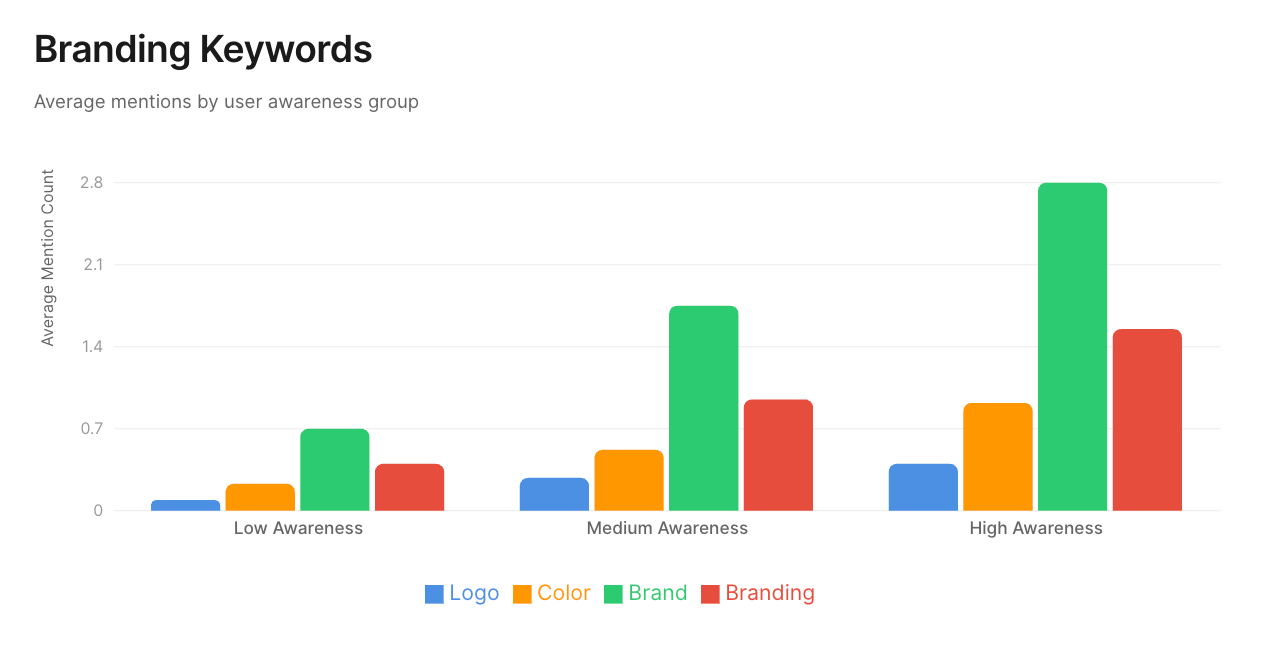
The truth is loud and clear:
- Most users don’t mention branding at all.
- And when they do, they lean heavily on a single term—“brand.”
In fact, “brand” was the most predictive keyword of branding awareness across the board. Among high-awareness users, it was mentioned on average over 10 times more than in the low-awareness group.
Let that sink in: Half of all users in our data didn’t mention a single brand keyword. Not even once.
So what did they type instead?
- “Add our logo.”
- “Use company colors.”
- “Professional tone.”
And then they clicked generate and hoped for on-brand magic.
The Say-Do Gap
Let me be real with you for a second:
The ask is basic. The expectation is not.
This is the brand-AI paradox. People want strategic, emotionally intelligent design — and they’re prompting it like they’re ordering coffee.
This isn’t a failure of the user. This is a signal to the product team. A very loud, very clear one.
And at Decktopus AI, we’ve heard it.
That’s why we offer:
- “Light branding”: Logo, colors, and fonts — instantly applied, even if the user never asks.
- And for teams who want brand guardianship on autopilot:
100% branding compliance via our Enterprise plans. No guesswork. No forgotten hex codes. No mismatched vibes.
In Part II, we’ll look deeper at what the data actually says users want from AI — even when they don’t say it out loud.
Because beneath the logos and color prompts, there’s something deeper:
A desire for the AI to get it. Emotionally, strategically, and instantly.
The Data-Driven Desire: What Users Really Want
Here’s the fascinating part: when users don’t ask directly for “brand,” what they actually want becomes even more revealing.
Because behind every “add our logo” is an unspoken plea:
“Please don’t embarrass me in front of the VP.”
Our prompt analysis exposed a quiet truth: users aren’t just delegating formatting — they’re trying to offload brand judgment. They want the AI to intuit the moment, the tone, the vibe — even when they don’t say it explicitly.
Let’s unpack the three big “hidden asks” your teams are signaling.
1. Compliance Without Prompting
When users don’t type “brand” but still expect things to look on-brand, that’s a system design issue, not a user flaw.
In our dataset, we found that:
- Even brand-aware users often skipped “logo” and “color” keywords in prompts.
- But they still expected the output to follow brand rules — layout, typeface, palette, and tone.
This is where IT and Procurement leaders need to rethink ROI.
It’s not just about how many decks get made — it’s about how few of them require fixing.
That’s exactly why Decktopus AI’s Business and Enterprise plans include full brand control.
- No more re-uploading logos.
- No more "what font is this?" Slack messages.
- Just always-on, auto-enforced brand identity, without needing a 5-sentence prompt.
Because your brand shouldn’t rely on user memory.
2. Emotional & Situational Awareness
Some users gave us gold — emotional prompts full of nuance:
“Investor update. Be sleek but reassuring.”
“Pitch for healthcare — formal but warm tone.”
“New product, early-stage, confident and visionary.”
No brand terms. No design notes.
But you know what those are? Brand signals. The kind that humans intuit — and AI needs to learn.
We found that high-awareness users are the ones most likely to do this kind of rich, contextual prompting.
And it’s no coincidence — they get that brand isn’t visual alone; it’s emotional.
So if you’re a Brand Manager, here’s your new mantra:
Feed the system, not the prompt.
Pre-load tone. Pre-ingest personas. Don’t rely on your sales team to remember that “bold yet empathetic” is your brand tone — bake it into the platform.
3. Minimal Prompts, Maximum Expectations
Most users? They don’t want to write to the AI like it’s a designer.
They want to type:
“Sales deck. Retail. Excited.”
...and get a deck that looks like it came out of your agency retainer.
That’s not unrealistic — it’s inevitable. Time is the most valuable currency in your organization.
So here’s the practical takeaway for your Sales and Consulting teams:
If you do need to prompt, make it matter.
👉 Upgrade from “Topic: Budget Planning” to:
“Internal budget review. Senior audience. Direct but optimistic tone.”
One sentence. Big difference. Because specificity costs you 6 seconds — but saves you 6 revisions.
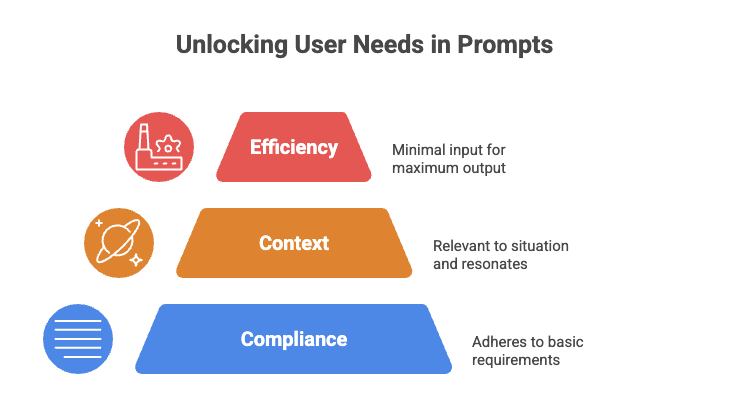
In next part, I’ll break it all down by role:
- What Brand Managers need to do now to stop prompt pollution
- What IT/Procurement should demand from AI vendors?
- And how Sales pros can upgrade their prompt game without adding work
The data is clear. The opportunity is clearer.
Actionable Takeaways for Our Focus Groups
Alright, we’ve talked data. We’ve exposed the say-do gap. Now let’s translate that insight into action. Because whether you lead a brand team, manage AI procurement, or hustle daily with sales decks — this is your cheat sheet.
👩🎨 For Brand Managers: Make the AI Know You
Let’s be honest: the prompt box is not where brand fidelity lives.
If you’re still relying on your teams to type “use our font” into every AI request, you’ve already lost the battle.
Here’s the play:
- Pre-ingest your identity: Fonts, colors, logos, tone of voice — all of it. Bake it into the AI tool before a single prompt is typed.
- Don’t expect magic from minimum input: Your teams are busy. Build systems where on-brand is the default — not a gamble.
🚨 Warning: Half your users (yes, even the “aware” ones) don’t mention brand keywords at all. You can’t afford to rely on memory or good intentions.
That’s why with Decktopus AI Business and Enterprise plans, your brand DNA is built into the tool. No prompting required.
💼 For IT & Procurement Leaders: Brand Compliance Is ROI
If you're evaluating AI tools solely on cost-per-user, you're missing the metric that matters: cost-per-off-brand-slide.
Every time your team has to fix a deck post-generation, that’s:
- Lost time ⏱
- Delayed deals 💸
- Inconsistent branding 🧩
And here’s what our data proves:
- Even users in the top 25% of brand awareness forget to prompt for colors or fonts.
- “Brand” gets mentioned a lot by power users, but compliance still isn’t consistent across the org.
Your new buying question isn’t “What can the AI do?”
It’s “What happens when the user forgets to ask?”
With Decktopus:
- Business plans enforce visual identity across every slide
- Enterprise plans can lock layouts, set role-based permissions, and enable full brand governance
So you’re not hoping for brand safety — you’re enforcing it.
💬 For Sales & Consulting Pros: Speak Like a Strategist, Not a Robot
Let’s face it: You want fast decks. But the fastest way to quality output isn’t typing “Product Overview” and praying.
Our prompt analysis showed:
- Low-effort prompts (one-liners) = basic, forgettable slides
- High-awareness users who included tone, audience, and emotion got way better results — consistently.
Want the shortcut?
Try this simple upgrade formula:
[Deck type] + [Audience] + [Emotion/Tone]
Examples:
- ❌ “Product Deck”
- ✅ “Product deck for retail execs. Clear and confident tone.”
- ❌ “Marketing Plan”
- ✅ “Marketing plan for Gen Z brand. Trendy, casual, persuasive tone.”
💡 You’re not prompting the tool. You’re briefing your creative partner. Treat it that way — and you’ll get better work, faster.
The Next Step in Branded AI
Let’s rewind for a second.
- We studied thousands of AI prompts.
- We learned most users never mention branding — even when they care deeply about it.
- We saw that the highest-performing users? They speak in tone, audience, and intention — not in font codes.
- And we realized: people don’t want to prompt for branding. They want branding to just… be there.
So where does this leave us?
The future of branded AI isn't just smarter tools — it’s smarter teams.
Teams who:
- Pre-load their brand DNA into their systems
- Stop relying on users to “remember” how the brand talks
- Teach AI how to feel like the company, not just look like it
We’re moving toward a world where you don’t have to say “make it on-brand.” It just is.
That’s the future we’re building at Decktopus AI.
Final Thought from Me (Alara)
If I’ve learned anything in my time as CMO, it’s this:
💡 Brand equity isn’t what you create — it’s what your team repeats, over and over, every single day.
And in a world where everyone’s using AI tools to create content faster, the only thing that’ll set you apart is how on-brand you can stay while moving at the speed of AI.
Let’s stop treating branding like glitter we sprinkle on at the end.
Let’s start building systems where brand is the first ingredient — not the afterthought.
Ask your Brand Manager one simple question today:
“Is our brand built into our AI tools — or are we crossing our fingers every time we hit generate?”
And if the answer makes you nervous? You know where to find us.
Decktopus AI: Light branding by default. Full brand power when it counts.
Frequently Asked Questions
1. What is a branded AI presentation?
A branded AI presentation is a slide deck generated by artificial intelligence tools that automatically incorporates a company’s brand elements—such as logo, colors, fonts, and tone of voice—into the design and content of the presentation.
2. Why don’t users mention brand keywords when using AI tools?
Our analysis showed that over 50% of users never mention brand-related terms in their prompts. This is likely because users expect AI tools to already know or apply their brand by default—especially under time pressure. It's a case of high expectations, low inputs.
3. How does Decktopus AI handle branding in presentations?
Decktopus AI offers light branding (logo, colors, fonts) to all users by default. For Business and Enterprise plans, it provides full brand control, allowing pre-ingestion of brand assets and tone to ensure 100% on-brand presentations—no prompting required.
4. What should teams include in AI prompts to improve branded output?
The most effective prompts include three components:
- Deck type or purpose (e.g., investor pitch, client onboarding)
- Audience (e.g., C-suite, Gen Z brand team)
- Tone or emotion (e.g., confident, formal, inspiring)
This combination leads to more accurate and brand-aligned results.
5. How can companies enforce brand consistency across AI tools?
CMOs and IT leaders can enforce consistency by choosing AI tools that support pre-loaded brand systems, automated brand compliance, and layout locking. Tools like Decktopus AI offer this level of control, particularly in enterprise settings.

.svg)
.svg)
.svg)










.svg)



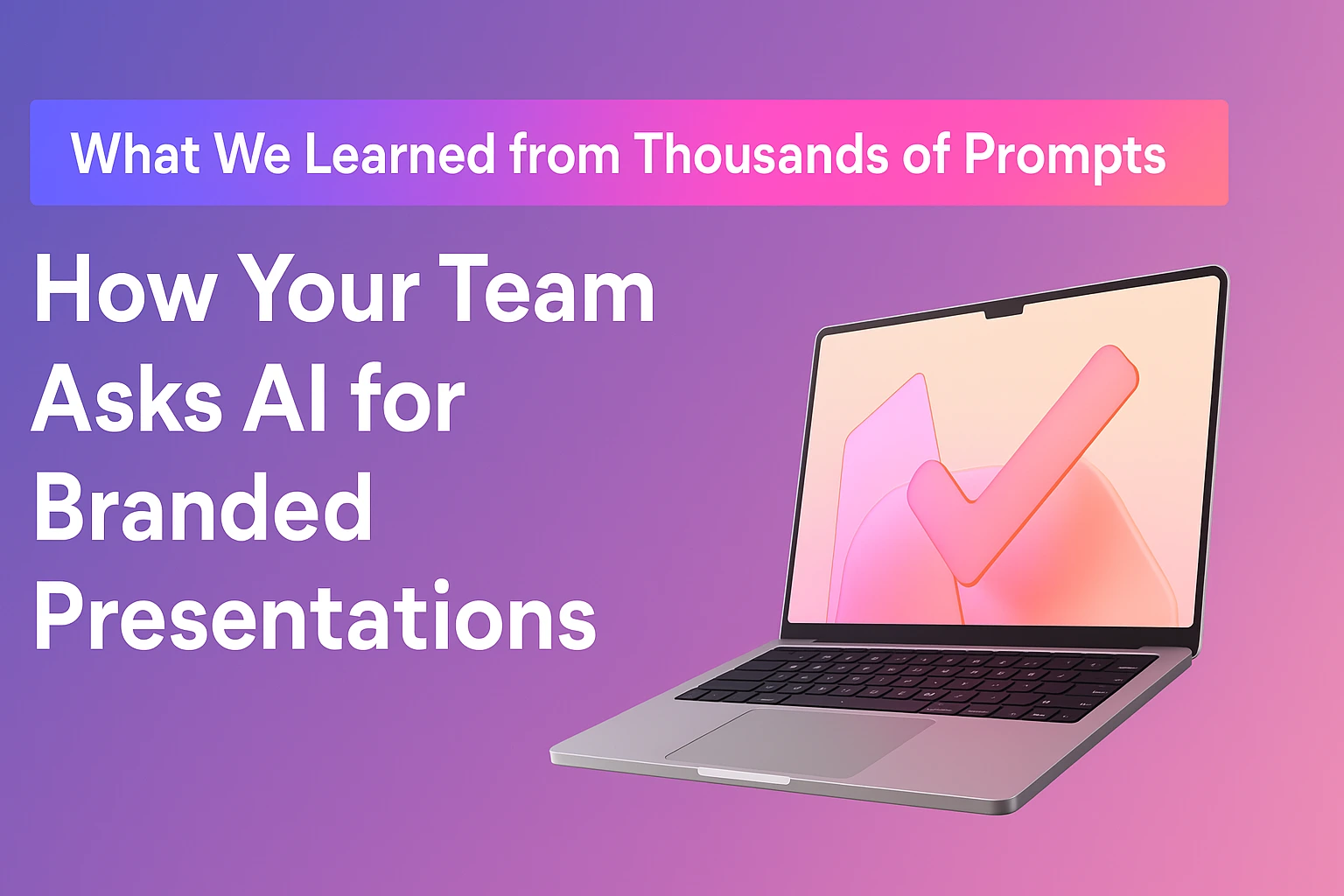
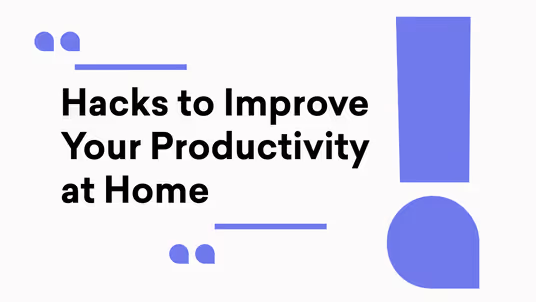
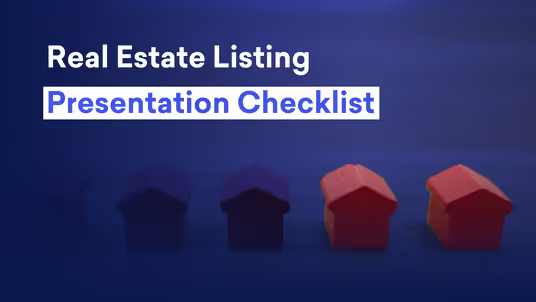






.svg)
.svg)
.svg)
.svg)
.svg)
.svg)
.svg)
